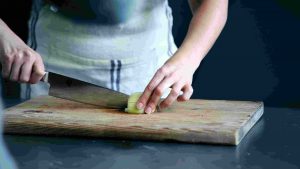
No doubt about it, because the kitchen is the main place for food preparation and eating, it is the hot spot for all types of pathogens (disease-causing microorganisms) that can cause foodborne illness. Cleanliness in the kitchen is a key component in reducing risk of foodborne illness.
Prevent Foodborne Illness
To reduce the risk of foodborne illness, it is necessary to first clean surfaces before sanitizing. Initially, the surface needs to be cleaned with warm soapy water to remove residues such as dirt and other debris that might be visible. Then the surface should be sanitized to reduce the number of organisms to a safe level. The most common organisms that cause foodborne illness in the kitchen are Salmonella, Campylobacter, and Norovirus.
While cleaning should be continuous throughout the food preparation process, the frequency of sanitizing will depend on your particular situation. Consider the vulnerability of your family members. Persons at greatest risk for foodborne illness include infants and young children, elderly, pregnant women, and those with weakened or compromised immune systems. Whether your family has special needs or not, it is fine to sanitize daily.
The most common home sanitizer is chlorine bleach. When properly diluted, it is a very effective sanitizer. The recommended concentration for food-contact surfaces is one scant teaspoon of 5% household, non-scented chlorine bleach to one quart water. Bleach with added fragrances is not safe for food surfaces. Other effective household sanitizers are 3% hydrogen peroxide and 3% white distilled vinegar. Since detergents and dirt interfere with the sanitizer’s ability to kill harmful microorganisms, the surface must first be cleaned. Remember to always properly dilute the sanitizer with clean water according to the manufacturer’s instructions.
Basic Steps for Cleaning and Sanitizing:

Clean: Wash with warm soapy water, rinse with clean water, and air dry or use a clean paper towel.
Sanitize: Spray surface with a sanitizing solution, leave on for recommended amount of time, and air dry or use a clean paper towel.
Click here to view the Ohio State University Extension Service’s publication Cleaning & Sanitizing the Kitchen Using Inexpensive Household Food-Safe Products for more information. And, please, keep your animals off kitchen surfaces!
 0
0
